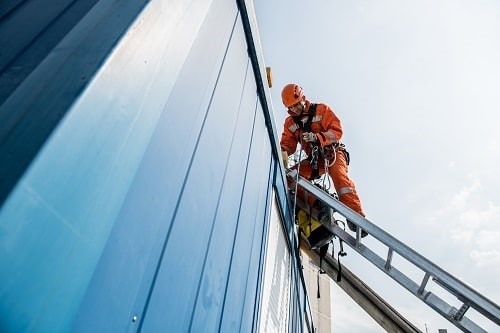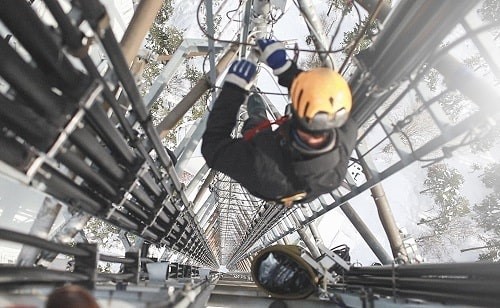With an average of 37 worker fatalities every year due to a fall from height, it is imperative that regulations are always followed by people working at height (WAH) and when working in hazardous environments. However, ruling out several myths surrounding WAH is the first step.
Features
Ten work at height myths debunked
1. It’s only a two-minute job, I don’t need fall protection equipment.
No matter how short or long the task, the time personnel spend WAH does not have any influence on requirements specified by the Work at Height Regulations.
Employers are required to ensure compliant fall protection equipment; a risk assessment and a rescue plan are all in place prior to personnel conducting any work at height activities. Whether personnel are conducting activities for two minutes, 20 minutes or two hours, the fall risk is equally the same.
Fall protection equipment, including PPE, saves worker lives and aids in preventing injuries, should a fall occur.
2. The work environment is only a few feet off the ground, so I don’t need fall protection equipment.
Most falls from height occur from relatively low heights, due to people underestimating risk. As specified by the Health and Safety Executive,“Work at Height means work in any place where, if precautions were not taken, a person could fall a distance liable to cause personal injury.”
Even though personnel may only be working a few metres above the ground, a fall could still result in serious injury should appropriate measures of protection not be in place. This is required by law.
 It is a myth to think that common sense is enough to work at height; common sense differs from person to person. Photograph: iStock/morfous
It is a myth to think that common sense is enough to work at height; common sense differs from person to person. Photograph: iStock/morfous
3. Fall protection breaks the bank.
It is a common misconception that fall protection is expensive however, costs are all relative. Prevention of accidents should be a number one priority for employers of personnel working in high risk environments, such as at height. An investment into specialist fall protection equipment, regular compliance testing, as well as associated personnel training, will prevent accidents with potentially fatal or life-changing injuries.
Consider how accident investigations fees, HSE fines, compensation costs, negative press and potential down time for your business, as well as potential imprisonment of owners, will cost much more than installing and maintaining a fall protection system. It is also worth bearing in mind that witnessing an accident or fatality can have a major negative impact on other personnel at work – resulting in a loss of productivity.
4. Wearing a harness and attaching a lanyard to an anchor point means that I’m safe.
Simply attaching to a safety line does not mean personnel are protected safely – fall clearance should be of key focus, as this will ensure that personnel are prevented from coming into contact with anything if a fall were to occur; for example, a lower roof level, a roof access system.
To calculate the fall clearance, Heightsafe’s specialists use the following method: free fall distance + arrest distance + harness stretch + safety factor = fall clearance.
 Before you use your PPE check each time for any signs of damage or deterioration
Before you use your PPE check each time for any signs of damage or deterioration
5. Fall protection is common sense.
It is certainly not common sense – common sense differs from person to person and indeed from site to site. Preventing falls from height is not only using compliant fall protection equipment, but also through an adequately trained workforce who are competent to undertake the required tasks while WAH.
6. My PPE was inspected last week; I don’t have to check it again.
When using PPE for work at height, or for any other activities, a pre-use check should always be completed. That is generally a visual inspection, checking for any signs of damage or deterioration. If any irregularities are found, the equipment should not be used until marked as compliant by a competent specialist.
It is recommended having all PPE used for work at height visually inspected every six months, and fully tested for compliance every 12 months. It is important to remember that each piece of PPE has a specified life span and, once the PPE kit has reached its life span, it will need to be replaced, regardless of how many times it has been used.
TIP: dangers may be existing under excessive dirt – ensure the PPE and fall protection equipment is clean at all times.
7. Emergency services will rescue personnel who have fallen from height.
Emergency services may not be equipped to perform a specialist rescue that has occurred due to a fall from height. Besides, a fall could take place in an area where the emergency services may not be able to reach you quickly enough.
Suspension trauma (also known as orthostatic intolerance or suspension syncope), is highly likely after any fall from height when a person is suspended upright in a harness. If a rescue has not been achieved within 10 minutes, blood can begin to pool in the legs, resulting in the heart, lungs and eventually the brain being starved of blood and oxygen.
Suspension trauma should be taken as a serious likelihood in the event of a fall from height; it is therefore imperative that bespoke rescue plans are created for all sites in which personnel are WAH. It is also important to ensure that they are competent to complete the rescue procedure, should a fall occur.
8. I can minimise injuries by reacting quickly in the event of a fall.
It takes approximately six metres before your brain will be fully aware that you have fallen, and at this time, it will be almost physically impossible to stop your fall, assuming you are conscious when you fall.
9. Health and safety regulations do not benefit me.
Health and safety regulations do in fact benefit everyone, as they command safe working environments and safe measures of protection for personnel working in hazardous environments.
Regulations continue to make work environments safer and help to mitigate risks posed for people WAH. In the UK alone, it is estimated that
225 more people per year now go home safely at the end of the working day due to clearer health and safety requirements
10. Fall protection equipment is suitable for all work activities.
Roof build ups vary massively from site to site, so it is imperative that an appropriate personal or collective measure of protection is selected to suit required activities. All sites should be surveyed by a competent specialist to ensure that the most effective fall protection equipment is in place to protect personnel WAH.
TIP: working in fall restraint (i.e. preventing falls from happening with guardrails, handrails and edge protection) requires a different type of equipment than working in fall arrest (i.e. arresting a fall should it occur with personal fall protection safety lines and specialist PPE).
Faced with multiple hazards at any one time, it is important to ensure that people WAH are not misinformed on the regulations designed to protect them. By ensuring that workers are appropriately trained to undertake the activities required, employers can have peace of mind knowing that their employees are able to identify hazards, use equipment correctly and are equipped to separate truth from myths.
Work at Height Regulations at: http://www.hse.gov.uk/work-at-height/the-law.htm
Ken Diable is managing director, HeightSafe Systems
FEATURES

Sedentary working and how to combat the ‘sitting disease’
By Gavin Bradley, Active Working on 05 April 2024
Prolonged and excessive sitting poses a major risk to our health, but the Get Britain Standing campaign and On Your Feet Britain Day on 25 April are a great way of encouraging workers to sit less and move more.

Company culture and wellbeing: a crucial link
By Bex Moorhouse, Invigorate Spaces on 05 April 2024
Investing in measures to support worker wellbeing will be ineffective unless the company culture genuinely incorporates values like teamwork, involvement, flexibility and innovation.

Office design and culture: happier and healthier staff – or the opposite?
By Guy Osmond, Osmond Ergonomics on 03 April 2024
Applying ergonomic principles to workstation set-ups and ensuring the physical environment supports neurodivergent people are just some of the ways of creating an office where everyone can thrive, but a supportive and positive organisational culture is vital too.


